University Work Health Safety Assessment: PUBH6002
VerifiedAdded on 2022/10/12
|12
|2345
|449
Report
AI Summary
This report provides a comprehensive work health safety assessment focusing on environmental health issues within the context of Australian workplaces. It begins with an introduction highlighting the prevalence of asbestos and its impact on public health, particularly concerning the James Hardie Industries. The report explores the organization's association with asbestos exposure, leading to health issues among employees, and reviews relevant legislations and regulations. A case study analyzes the company's work environment, identifying various hazards such as chemical, physical, biophysical, mechanical, and environmental risks, and uses a risk matrix to evaluate their likelihood and impact. The report then details a risk mitigation plan, outlining hazards, associated harms, existing controls, and residual risk ratings. It concludes by emphasizing the importance of improved workplace environments, the provision of safety gear, and adherence to health and safety standards to protect employees. The report references various sources to support its findings and recommendations.
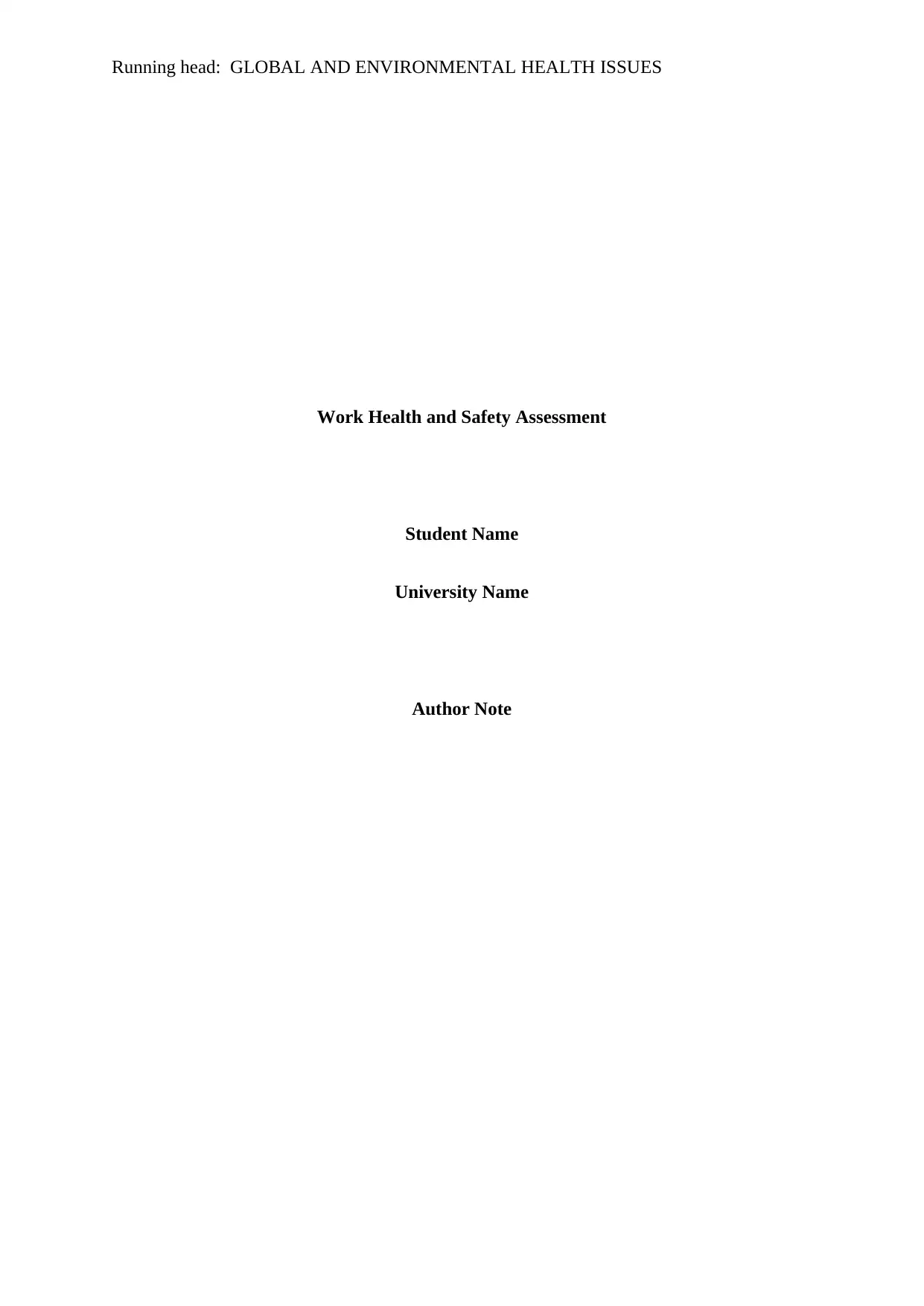
Running head: GLOBAL AND ENVIRONMENTAL HEALTH ISSUES
Work Health and Safety Assessment
Student Name
University Name
Author Note
Work Health and Safety Assessment
Student Name
University Name
Author Note
Paraphrase This Document
Need a fresh take? Get an instant paraphrase of this document with our AI Paraphraser
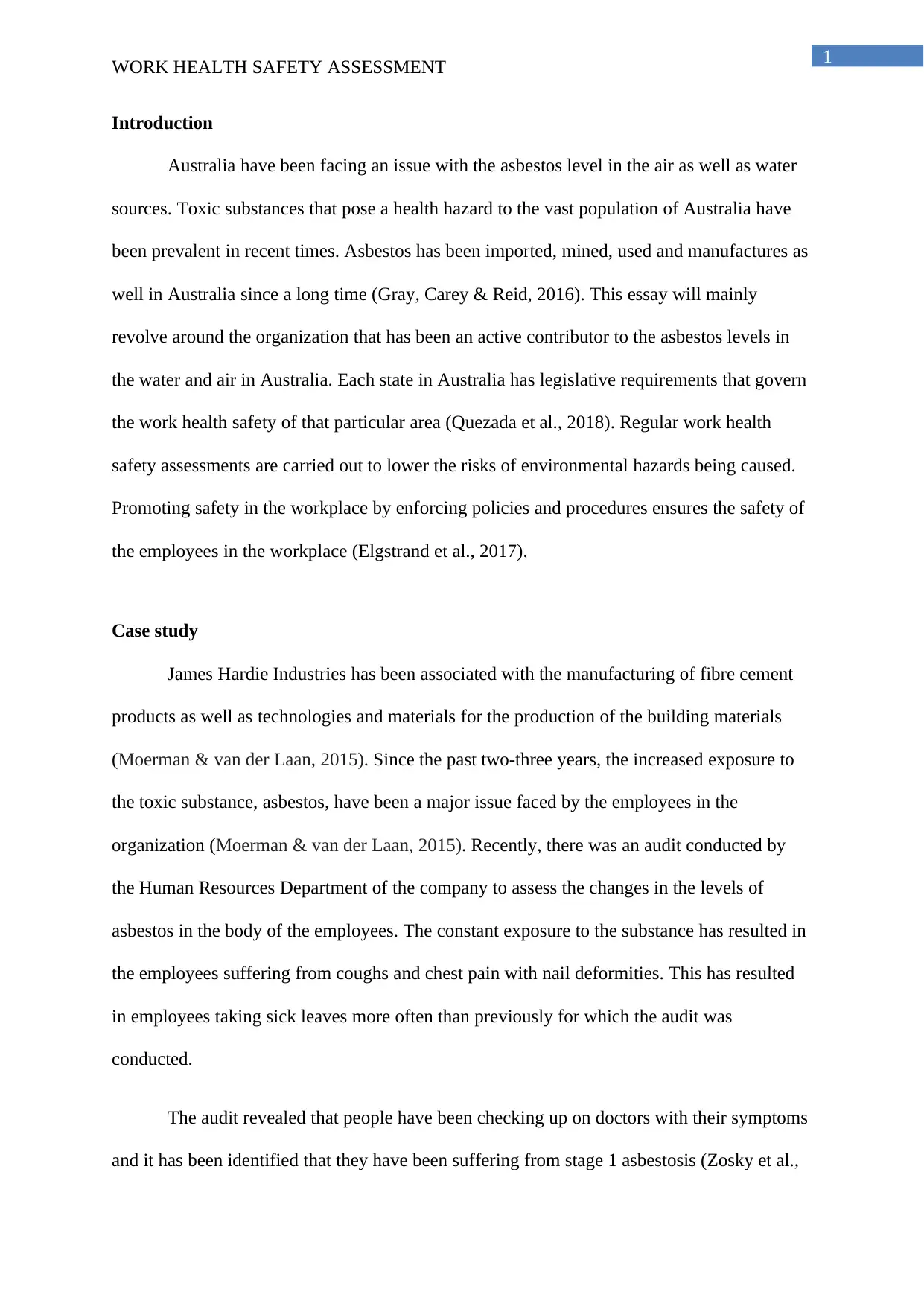
1
WORK HEALTH SAFETY ASSESSMENT
Introduction
Australia have been facing an issue with the asbestos level in the air as well as water
sources. Toxic substances that pose a health hazard to the vast population of Australia have
been prevalent in recent times. Asbestos has been imported, mined, used and manufactures as
well in Australia since a long time (Gray, Carey & Reid, 2016). This essay will mainly
revolve around the organization that has been an active contributor to the asbestos levels in
the water and air in Australia. Each state in Australia has legislative requirements that govern
the work health safety of that particular area (Quezada et al., 2018). Regular work health
safety assessments are carried out to lower the risks of environmental hazards being caused.
Promoting safety in the workplace by enforcing policies and procedures ensures the safety of
the employees in the workplace (Elgstrand et al., 2017).
Case study
James Hardie Industries has been associated with the manufacturing of fibre cement
products as well as technologies and materials for the production of the building materials
(Moerman & van der Laan, 2015). Since the past two-three years, the increased exposure to
the toxic substance, asbestos, have been a major issue faced by the employees in the
organization (Moerman & van der Laan, 2015). Recently, there was an audit conducted by
the Human Resources Department of the company to assess the changes in the levels of
asbestos in the body of the employees. The constant exposure to the substance has resulted in
the employees suffering from coughs and chest pain with nail deformities. This has resulted
in employees taking sick leaves more often than previously for which the audit was
conducted.
The audit revealed that people have been checking up on doctors with their symptoms
and it has been identified that they have been suffering from stage 1 asbestosis (Zosky et al.,
WORK HEALTH SAFETY ASSESSMENT
Introduction
Australia have been facing an issue with the asbestos level in the air as well as water
sources. Toxic substances that pose a health hazard to the vast population of Australia have
been prevalent in recent times. Asbestos has been imported, mined, used and manufactures as
well in Australia since a long time (Gray, Carey & Reid, 2016). This essay will mainly
revolve around the organization that has been an active contributor to the asbestos levels in
the water and air in Australia. Each state in Australia has legislative requirements that govern
the work health safety of that particular area (Quezada et al., 2018). Regular work health
safety assessments are carried out to lower the risks of environmental hazards being caused.
Promoting safety in the workplace by enforcing policies and procedures ensures the safety of
the employees in the workplace (Elgstrand et al., 2017).
Case study
James Hardie Industries has been associated with the manufacturing of fibre cement
products as well as technologies and materials for the production of the building materials
(Moerman & van der Laan, 2015). Since the past two-three years, the increased exposure to
the toxic substance, asbestos, have been a major issue faced by the employees in the
organization (Moerman & van der Laan, 2015). Recently, there was an audit conducted by
the Human Resources Department of the company to assess the changes in the levels of
asbestos in the body of the employees. The constant exposure to the substance has resulted in
the employees suffering from coughs and chest pain with nail deformities. This has resulted
in employees taking sick leaves more often than previously for which the audit was
conducted.
The audit revealed that people have been checking up on doctors with their symptoms
and it has been identified that they have been suffering from stage 1 asbestosis (Zosky et al.,
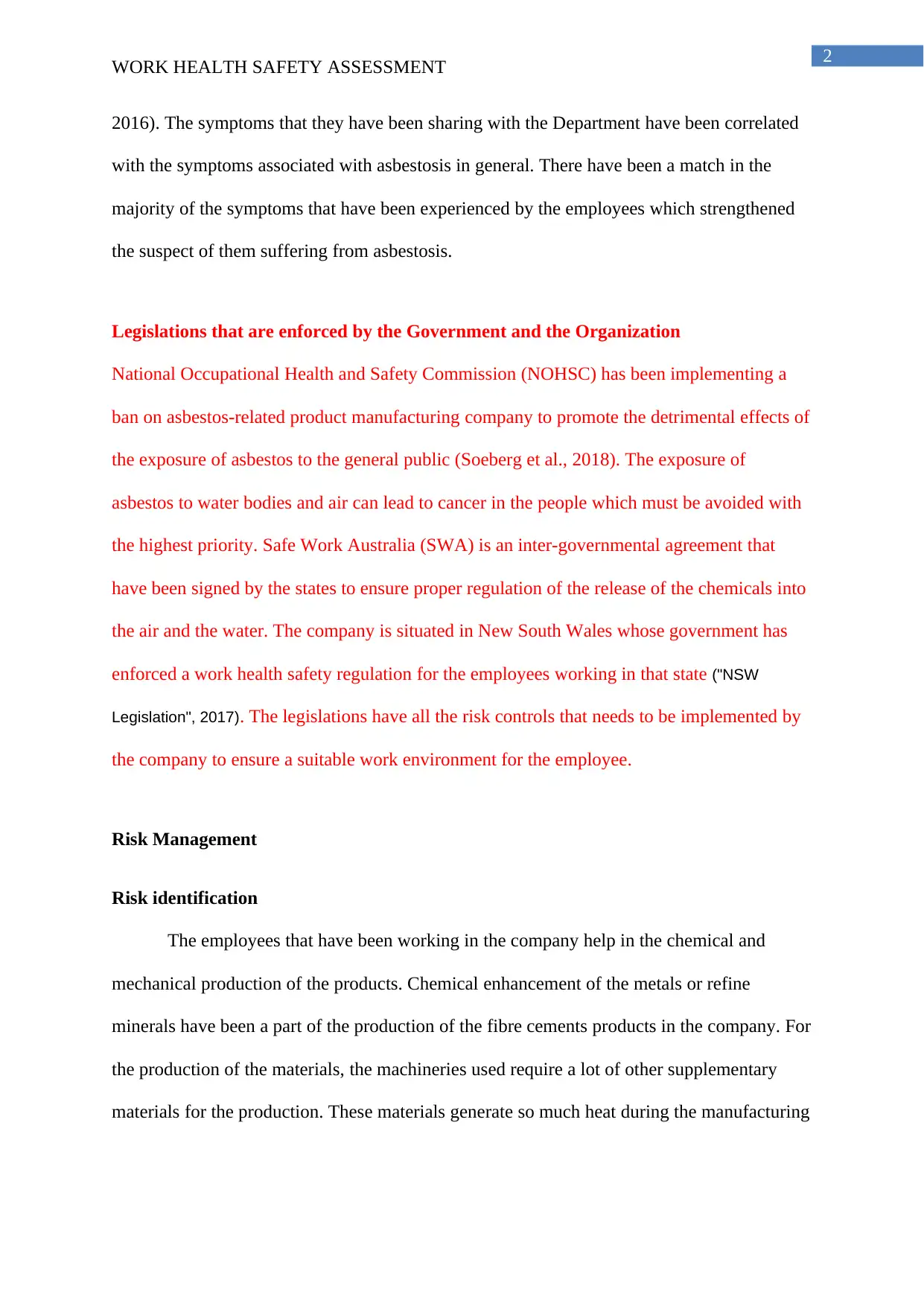
2
WORK HEALTH SAFETY ASSESSMENT
2016). The symptoms that they have been sharing with the Department have been correlated
with the symptoms associated with asbestosis in general. There have been a match in the
majority of the symptoms that have been experienced by the employees which strengthened
the suspect of them suffering from asbestosis.
Legislations that are enforced by the Government and the Organization
National Occupational Health and Safety Commission (NOHSC) has been implementing a
ban on asbestos-related product manufacturing company to promote the detrimental effects of
the exposure of asbestos to the general public (Soeberg et al., 2018). The exposure of
asbestos to water bodies and air can lead to cancer in the people which must be avoided with
the highest priority. Safe Work Australia (SWA) is an inter-governmental agreement that
have been signed by the states to ensure proper regulation of the release of the chemicals into
the air and the water. The company is situated in New South Wales whose government has
enforced a work health safety regulation for the employees working in that state ("NSW
Legislation", 2017). The legislations have all the risk controls that needs to be implemented by
the company to ensure a suitable work environment for the employee.
Risk Management
Risk identification
The employees that have been working in the company help in the chemical and
mechanical production of the products. Chemical enhancement of the metals or refine
minerals have been a part of the production of the fibre cements products in the company. For
the production of the materials, the machineries used require a lot of other supplementary
materials for the production. These materials generate so much heat during the manufacturing
WORK HEALTH SAFETY ASSESSMENT
2016). The symptoms that they have been sharing with the Department have been correlated
with the symptoms associated with asbestosis in general. There have been a match in the
majority of the symptoms that have been experienced by the employees which strengthened
the suspect of them suffering from asbestosis.
Legislations that are enforced by the Government and the Organization
National Occupational Health and Safety Commission (NOHSC) has been implementing a
ban on asbestos-related product manufacturing company to promote the detrimental effects of
the exposure of asbestos to the general public (Soeberg et al., 2018). The exposure of
asbestos to water bodies and air can lead to cancer in the people which must be avoided with
the highest priority. Safe Work Australia (SWA) is an inter-governmental agreement that
have been signed by the states to ensure proper regulation of the release of the chemicals into
the air and the water. The company is situated in New South Wales whose government has
enforced a work health safety regulation for the employees working in that state ("NSW
Legislation", 2017). The legislations have all the risk controls that needs to be implemented by
the company to ensure a suitable work environment for the employee.
Risk Management
Risk identification
The employees that have been working in the company help in the chemical and
mechanical production of the products. Chemical enhancement of the metals or refine
minerals have been a part of the production of the fibre cements products in the company. For
the production of the materials, the machineries used require a lot of other supplementary
materials for the production. These materials generate so much heat during the manufacturing
⊘ This is a preview!⊘
Do you want full access?
Subscribe today to unlock all pages.

Trusted by 1+ million students worldwide
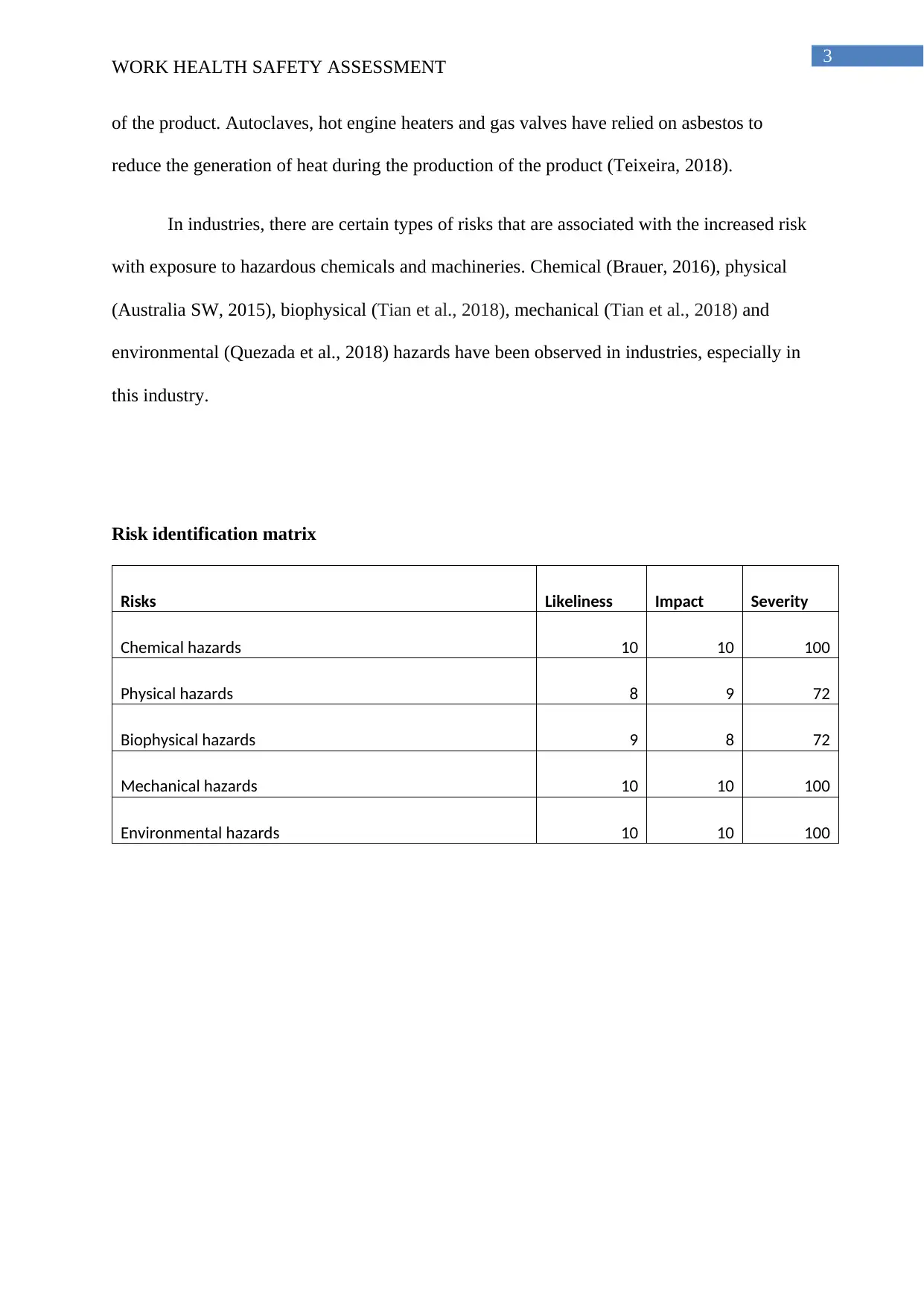
3
WORK HEALTH SAFETY ASSESSMENT
of the product. Autoclaves, hot engine heaters and gas valves have relied on asbestos to
reduce the generation of heat during the production of the product (Teixeira, 2018).
In industries, there are certain types of risks that are associated with the increased risk
with exposure to hazardous chemicals and machineries. Chemical (Brauer, 2016), physical
(Australia SW, 2015), biophysical (Tian et al., 2018), mechanical (Tian et al., 2018) and
environmental (Quezada et al., 2018) hazards have been observed in industries, especially in
this industry.
Risk identification matrix
Risks Likeliness Impact Severity
Chemical hazards 10 10 100
Physical hazards 8 9 72
Biophysical hazards 9 8 72
Mechanical hazards 10 10 100
Environmental hazards 10 10 100
WORK HEALTH SAFETY ASSESSMENT
of the product. Autoclaves, hot engine heaters and gas valves have relied on asbestos to
reduce the generation of heat during the production of the product (Teixeira, 2018).
In industries, there are certain types of risks that are associated with the increased risk
with exposure to hazardous chemicals and machineries. Chemical (Brauer, 2016), physical
(Australia SW, 2015), biophysical (Tian et al., 2018), mechanical (Tian et al., 2018) and
environmental (Quezada et al., 2018) hazards have been observed in industries, especially in
this industry.
Risk identification matrix
Risks Likeliness Impact Severity
Chemical hazards 10 10 100
Physical hazards 8 9 72
Biophysical hazards 9 8 72
Mechanical hazards 10 10 100
Environmental hazards 10 10 100
Paraphrase This Document
Need a fresh take? Get an instant paraphrase of this document with our AI Paraphraser
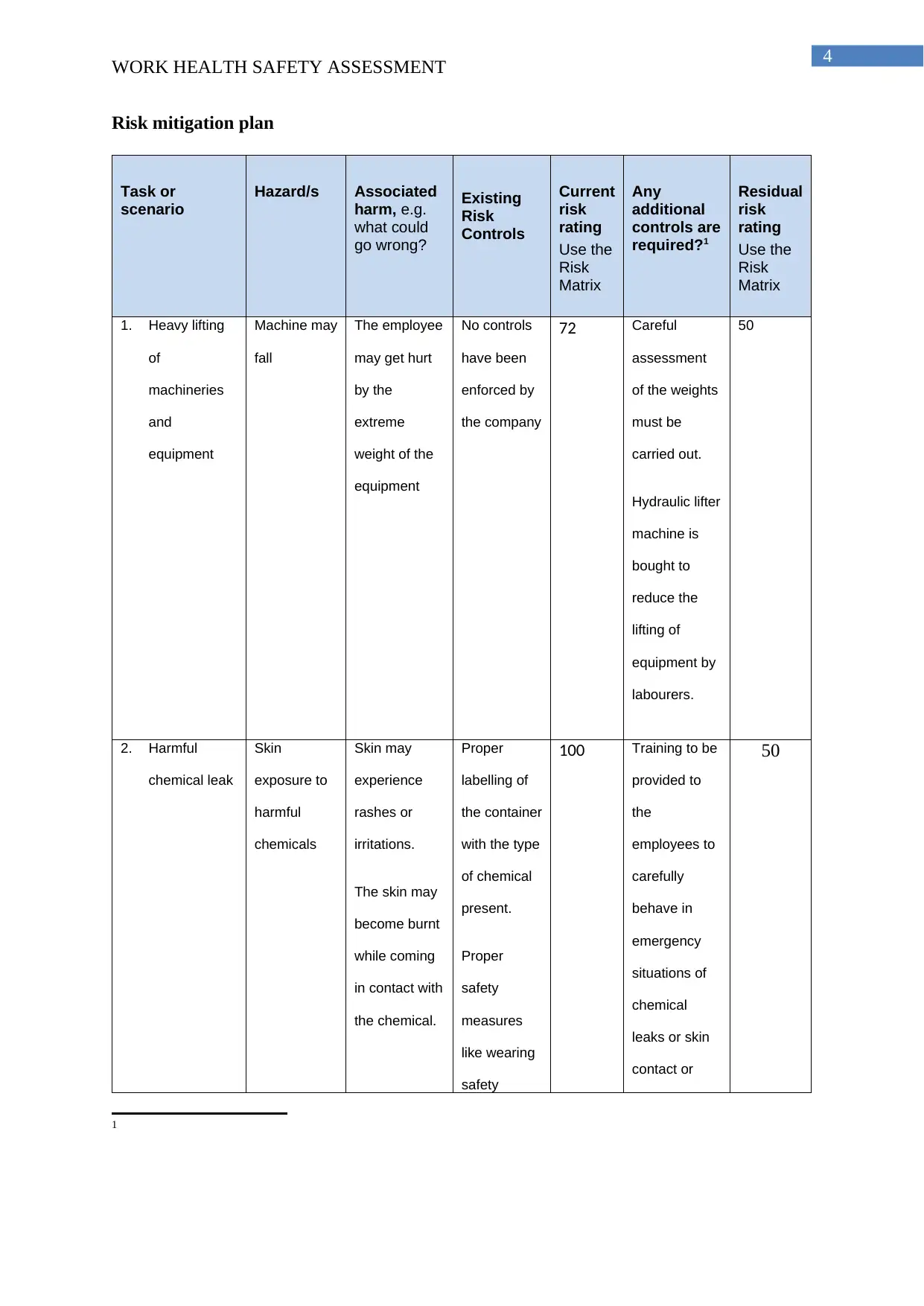
4
WORK HEALTH SAFETY ASSESSMENT
Risk mitigation plan
Task or
scenario
Hazard/s Associated
harm, e.g.
what could
go wrong?
Existing
Risk
Controls
Current
risk
rating
Use the
Risk
Matrix
Any
additional
controls are
required?1
Residual
risk
rating
Use the
Risk
Matrix
1. Heavy lifting
of
machineries
and
equipment
Machine may
fall
The employee
may get hurt
by the
extreme
weight of the
equipment
No controls
have been
enforced by
the company
72 Careful
assessment
of the weights
must be
carried out.
Hydraulic lifter
machine is
bought to
reduce the
lifting of
equipment by
labourers.
50
2. Harmful
chemical leak
Skin
exposure to
harmful
chemicals
Skin may
experience
rashes or
irritations.
The skin may
become burnt
while coming
in contact with
the chemical.
Proper
labelling of
the container
with the type
of chemical
present.
Proper
safety
measures
like wearing
safety
100 Training to be
provided to
the
employees to
carefully
behave in
emergency
situations of
chemical
leaks or skin
contact or
50
1
WORK HEALTH SAFETY ASSESSMENT
Risk mitigation plan
Task or
scenario
Hazard/s Associated
harm, e.g.
what could
go wrong?
Existing
Risk
Controls
Current
risk
rating
Use the
Risk
Matrix
Any
additional
controls are
required?1
Residual
risk
rating
Use the
Risk
Matrix
1. Heavy lifting
of
machineries
and
equipment
Machine may
fall
The employee
may get hurt
by the
extreme
weight of the
equipment
No controls
have been
enforced by
the company
72 Careful
assessment
of the weights
must be
carried out.
Hydraulic lifter
machine is
bought to
reduce the
lifting of
equipment by
labourers.
50
2. Harmful
chemical leak
Skin
exposure to
harmful
chemicals
Skin may
experience
rashes or
irritations.
The skin may
become burnt
while coming
in contact with
the chemical.
Proper
labelling of
the container
with the type
of chemical
present.
Proper
safety
measures
like wearing
safety
100 Training to be
provided to
the
employees to
carefully
behave in
emergency
situations of
chemical
leaks or skin
contact or
50
1
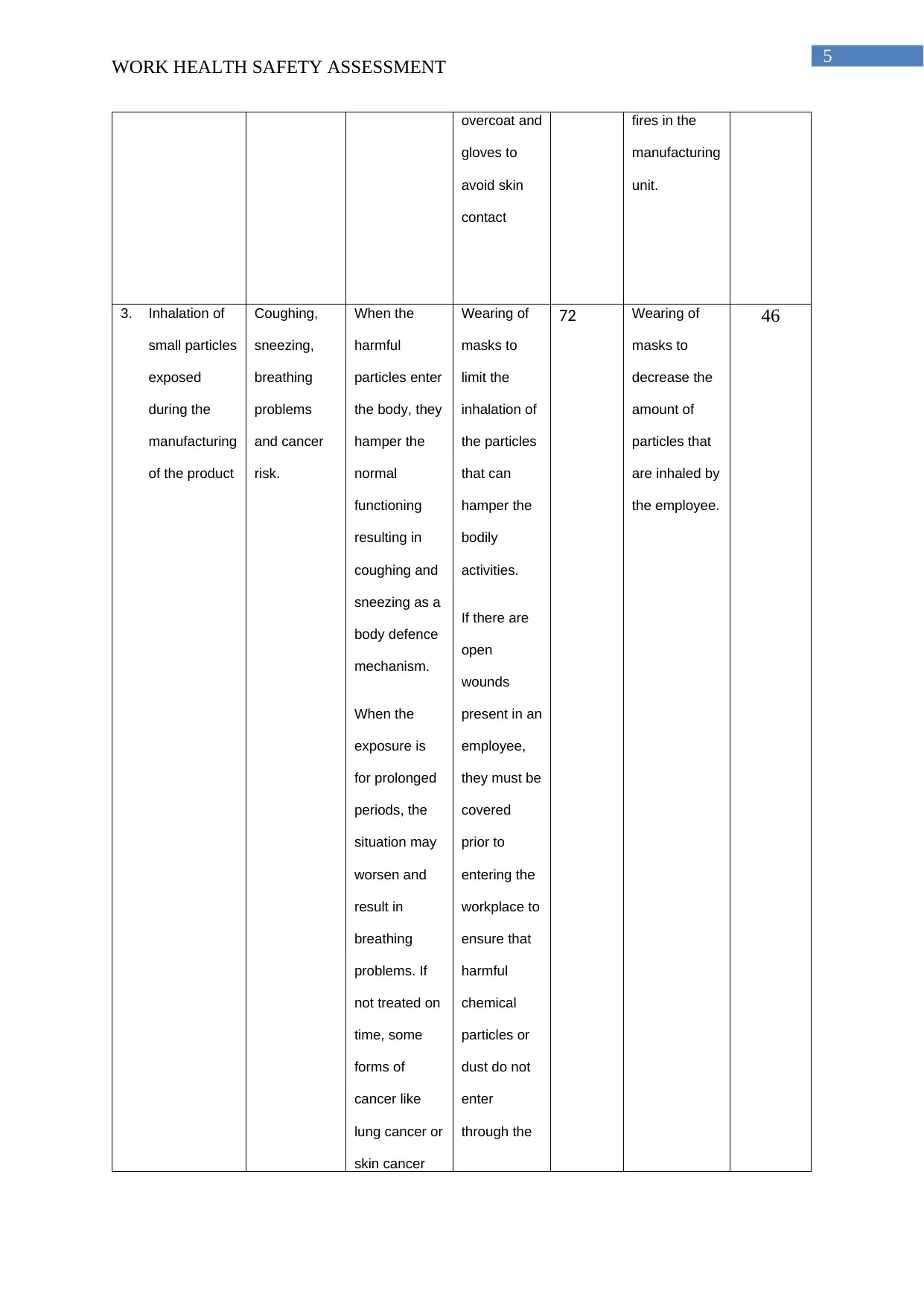
5
WORK HEALTH SAFETY ASSESSMENT
overcoat and
gloves to
avoid skin
contact
fires in the
manufacturing
unit.
3. Inhalation of
small particles
exposed
during the
manufacturing
of the product
Coughing,
sneezing,
breathing
problems
and cancer
risk.
When the
harmful
particles enter
the body, they
hamper the
normal
functioning
resulting in
coughing and
sneezing as a
body defence
mechanism.
When the
exposure is
for prolonged
periods, the
situation may
worsen and
result in
breathing
problems. If
not treated on
time, some
forms of
cancer like
lung cancer or
skin cancer
Wearing of
masks to
limit the
inhalation of
the particles
that can
hamper the
bodily
activities.
If there are
open
wounds
present in an
employee,
they must be
covered
prior to
entering the
workplace to
ensure that
harmful
chemical
particles or
dust do not
enter
through the
72 Wearing of
masks to
decrease the
amount of
particles that
are inhaled by
the employee.
46
WORK HEALTH SAFETY ASSESSMENT
overcoat and
gloves to
avoid skin
contact
fires in the
manufacturing
unit.
3. Inhalation of
small particles
exposed
during the
manufacturing
of the product
Coughing,
sneezing,
breathing
problems
and cancer
risk.
When the
harmful
particles enter
the body, they
hamper the
normal
functioning
resulting in
coughing and
sneezing as a
body defence
mechanism.
When the
exposure is
for prolonged
periods, the
situation may
worsen and
result in
breathing
problems. If
not treated on
time, some
forms of
cancer like
lung cancer or
skin cancer
Wearing of
masks to
limit the
inhalation of
the particles
that can
hamper the
bodily
activities.
If there are
open
wounds
present in an
employee,
they must be
covered
prior to
entering the
workplace to
ensure that
harmful
chemical
particles or
dust do not
enter
through the
72 Wearing of
masks to
decrease the
amount of
particles that
are inhaled by
the employee.
46
⊘ This is a preview!⊘
Do you want full access?
Subscribe today to unlock all pages.

Trusted by 1+ million students worldwide
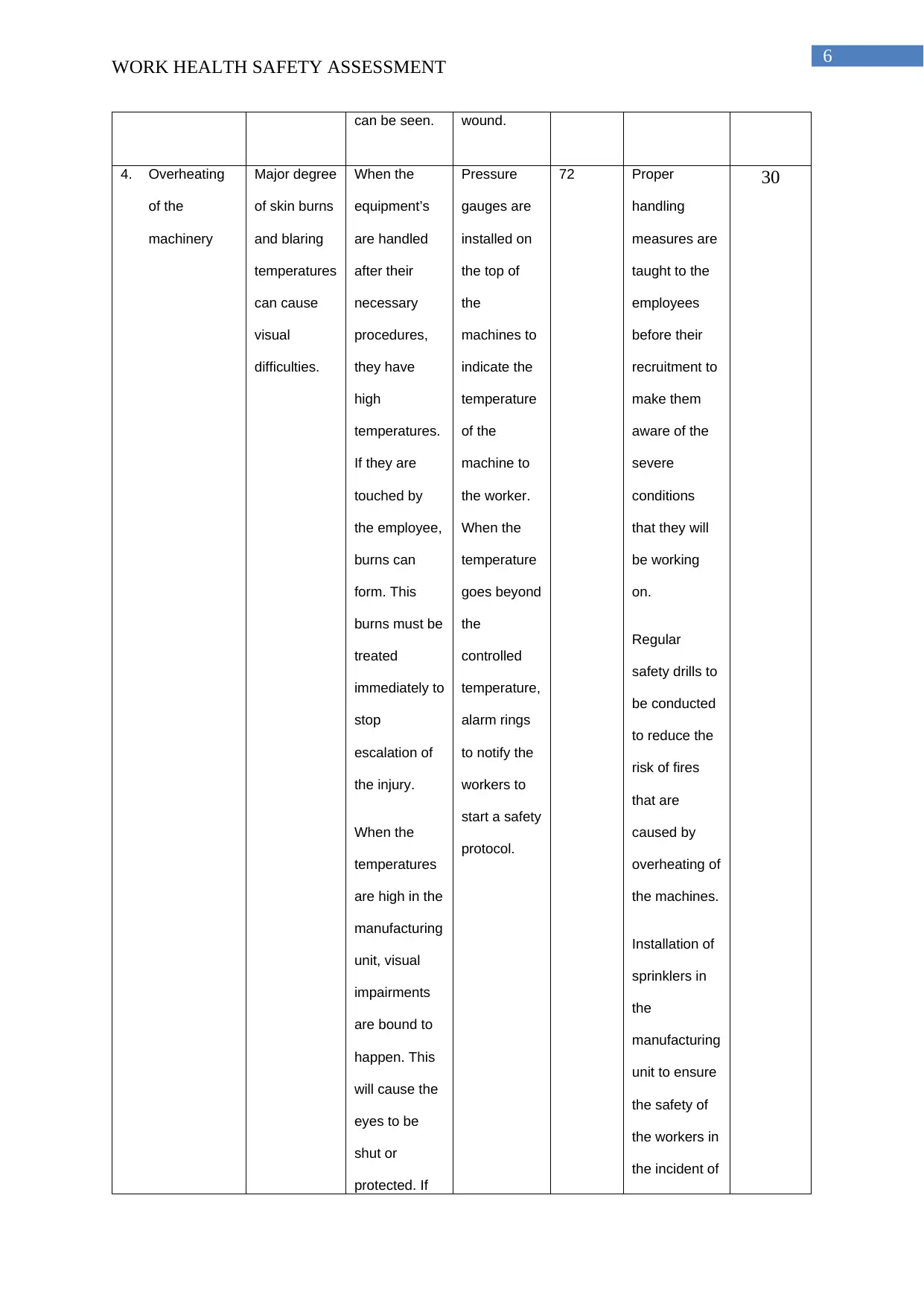
6
WORK HEALTH SAFETY ASSESSMENT
can be seen. wound.
4. Overheating
of the
machinery
Major degree
of skin burns
and blaring
temperatures
can cause
visual
difficulties.
When the
equipment’s
are handled
after their
necessary
procedures,
they have
high
temperatures.
If they are
touched by
the employee,
burns can
form. This
burns must be
treated
immediately to
stop
escalation of
the injury.
When the
temperatures
are high in the
manufacturing
unit, visual
impairments
are bound to
happen. This
will cause the
eyes to be
shut or
protected. If
Pressure
gauges are
installed on
the top of
the
machines to
indicate the
temperature
of the
machine to
the worker.
When the
temperature
goes beyond
the
controlled
temperature,
alarm rings
to notify the
workers to
start a safety
protocol.
72 Proper
handling
measures are
taught to the
employees
before their
recruitment to
make them
aware of the
severe
conditions
that they will
be working
on.
Regular
safety drills to
be conducted
to reduce the
risk of fires
that are
caused by
overheating of
the machines.
Installation of
sprinklers in
the
manufacturing
unit to ensure
the safety of
the workers in
the incident of
30
WORK HEALTH SAFETY ASSESSMENT
can be seen. wound.
4. Overheating
of the
machinery
Major degree
of skin burns
and blaring
temperatures
can cause
visual
difficulties.
When the
equipment’s
are handled
after their
necessary
procedures,
they have
high
temperatures.
If they are
touched by
the employee,
burns can
form. This
burns must be
treated
immediately to
stop
escalation of
the injury.
When the
temperatures
are high in the
manufacturing
unit, visual
impairments
are bound to
happen. This
will cause the
eyes to be
shut or
protected. If
Pressure
gauges are
installed on
the top of
the
machines to
indicate the
temperature
of the
machine to
the worker.
When the
temperature
goes beyond
the
controlled
temperature,
alarm rings
to notify the
workers to
start a safety
protocol.
72 Proper
handling
measures are
taught to the
employees
before their
recruitment to
make them
aware of the
severe
conditions
that they will
be working
on.
Regular
safety drills to
be conducted
to reduce the
risk of fires
that are
caused by
overheating of
the machines.
Installation of
sprinklers in
the
manufacturing
unit to ensure
the safety of
the workers in
the incident of
30
Paraphrase This Document
Need a fresh take? Get an instant paraphrase of this document with our AI Paraphraser
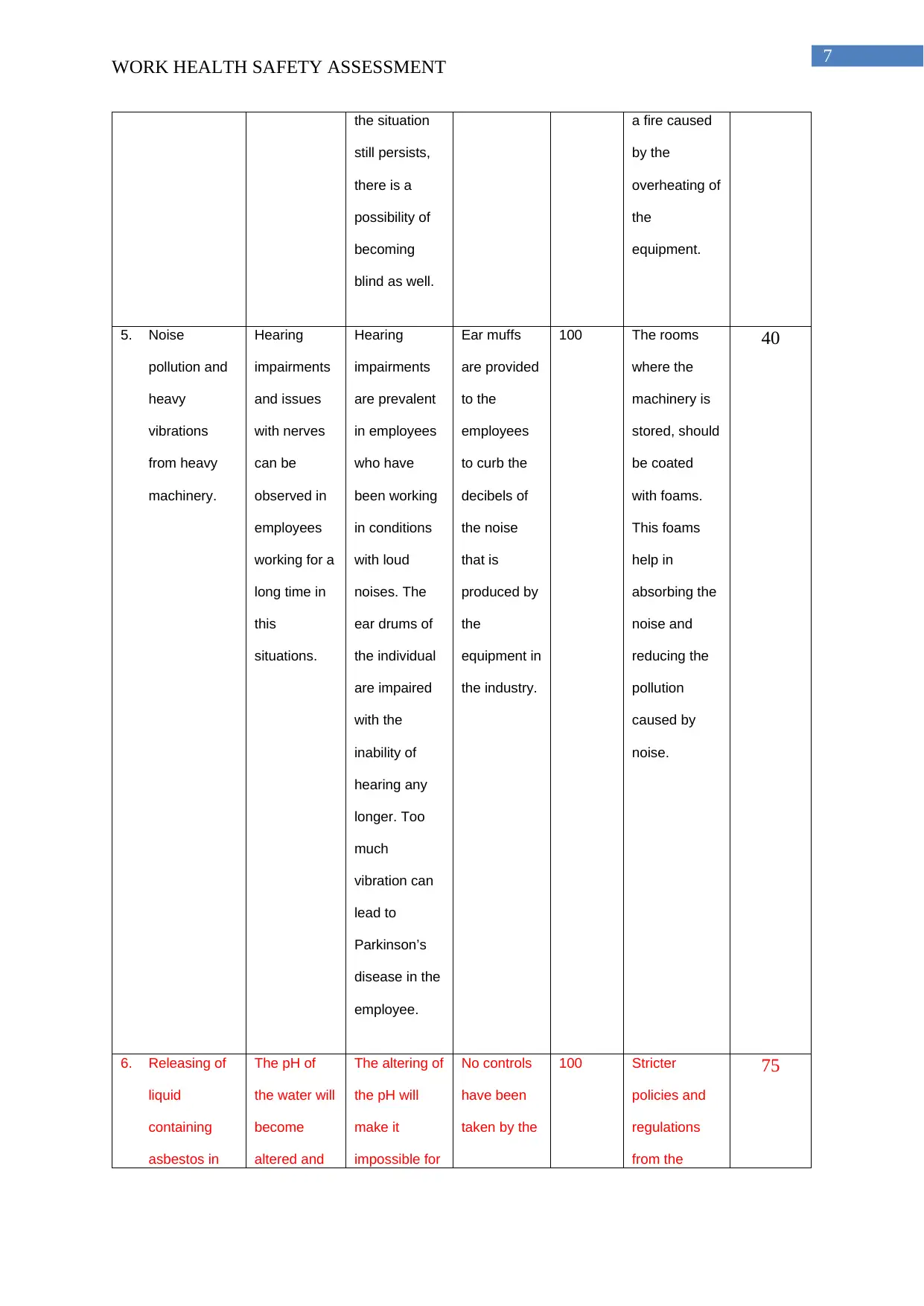
7
WORK HEALTH SAFETY ASSESSMENT
the situation
still persists,
there is a
possibility of
becoming
blind as well.
a fire caused
by the
overheating of
the
equipment.
5. Noise
pollution and
heavy
vibrations
from heavy
machinery.
Hearing
impairments
and issues
with nerves
can be
observed in
employees
working for a
long time in
this
situations.
Hearing
impairments
are prevalent
in employees
who have
been working
in conditions
with loud
noises. The
ear drums of
the individual
are impaired
with the
inability of
hearing any
longer. Too
much
vibration can
lead to
Parkinson’s
disease in the
employee.
Ear muffs
are provided
to the
employees
to curb the
decibels of
the noise
that is
produced by
the
equipment in
the industry.
100 The rooms
where the
machinery is
stored, should
be coated
with foams.
This foams
help in
absorbing the
noise and
reducing the
pollution
caused by
noise.
40
6. Releasing of
liquid
containing
asbestos in
The pH of
the water will
become
altered and
The altering of
the pH will
make it
impossible for
No controls
have been
taken by the
100 Stricter
policies and
regulations
from the
75
WORK HEALTH SAFETY ASSESSMENT
the situation
still persists,
there is a
possibility of
becoming
blind as well.
a fire caused
by the
overheating of
the
equipment.
5. Noise
pollution and
heavy
vibrations
from heavy
machinery.
Hearing
impairments
and issues
with nerves
can be
observed in
employees
working for a
long time in
this
situations.
Hearing
impairments
are prevalent
in employees
who have
been working
in conditions
with loud
noises. The
ear drums of
the individual
are impaired
with the
inability of
hearing any
longer. Too
much
vibration can
lead to
Parkinson’s
disease in the
employee.
Ear muffs
are provided
to the
employees
to curb the
decibels of
the noise
that is
produced by
the
equipment in
the industry.
100 The rooms
where the
machinery is
stored, should
be coated
with foams.
This foams
help in
absorbing the
noise and
reducing the
pollution
caused by
noise.
40
6. Releasing of
liquid
containing
asbestos in
The pH of
the water will
become
altered and
The altering of
the pH will
make it
impossible for
No controls
have been
taken by the
100 Stricter
policies and
regulations
from the
75
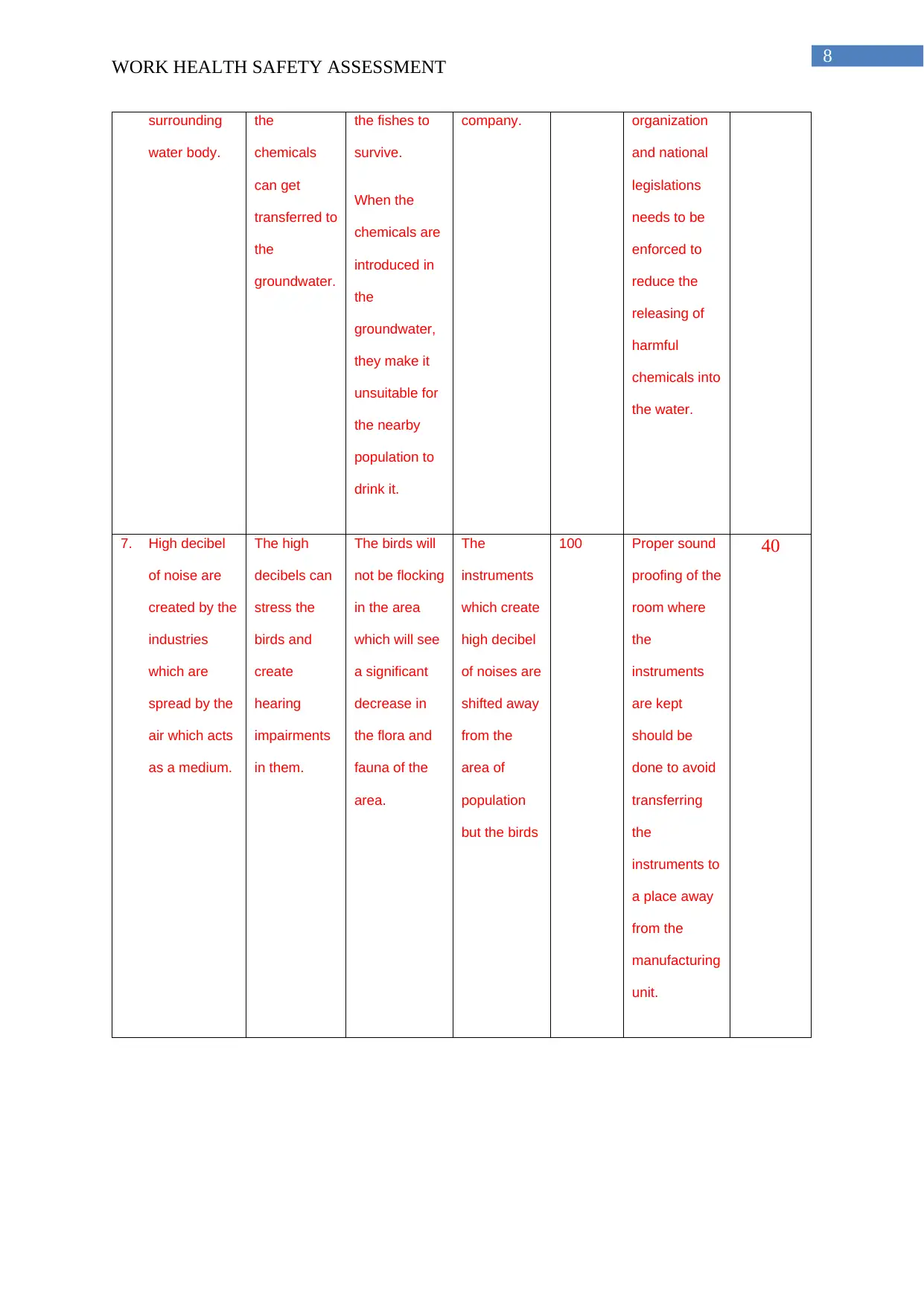
8
WORK HEALTH SAFETY ASSESSMENT
surrounding
water body.
the
chemicals
can get
transferred to
the
groundwater.
the fishes to
survive.
When the
chemicals are
introduced in
the
groundwater,
they make it
unsuitable for
the nearby
population to
drink it.
company. organization
and national
legislations
needs to be
enforced to
reduce the
releasing of
harmful
chemicals into
the water.
7. High decibel
of noise are
created by the
industries
which are
spread by the
air which acts
as a medium.
The high
decibels can
stress the
birds and
create
hearing
impairments
in them.
The birds will
not be flocking
in the area
which will see
a significant
decrease in
the flora and
fauna of the
area.
The
instruments
which create
high decibel
of noises are
shifted away
from the
area of
population
but the birds
100 Proper sound
proofing of the
room where
the
instruments
are kept
should be
done to avoid
transferring
the
instruments to
a place away
from the
manufacturing
unit.
40
WORK HEALTH SAFETY ASSESSMENT
surrounding
water body.
the
chemicals
can get
transferred to
the
groundwater.
the fishes to
survive.
When the
chemicals are
introduced in
the
groundwater,
they make it
unsuitable for
the nearby
population to
drink it.
company. organization
and national
legislations
needs to be
enforced to
reduce the
releasing of
harmful
chemicals into
the water.
7. High decibel
of noise are
created by the
industries
which are
spread by the
air which acts
as a medium.
The high
decibels can
stress the
birds and
create
hearing
impairments
in them.
The birds will
not be flocking
in the area
which will see
a significant
decrease in
the flora and
fauna of the
area.
The
instruments
which create
high decibel
of noises are
shifted away
from the
area of
population
but the birds
100 Proper sound
proofing of the
room where
the
instruments
are kept
should be
done to avoid
transferring
the
instruments to
a place away
from the
manufacturing
unit.
40
⊘ This is a preview!⊘
Do you want full access?
Subscribe today to unlock all pages.

Trusted by 1+ million students worldwide
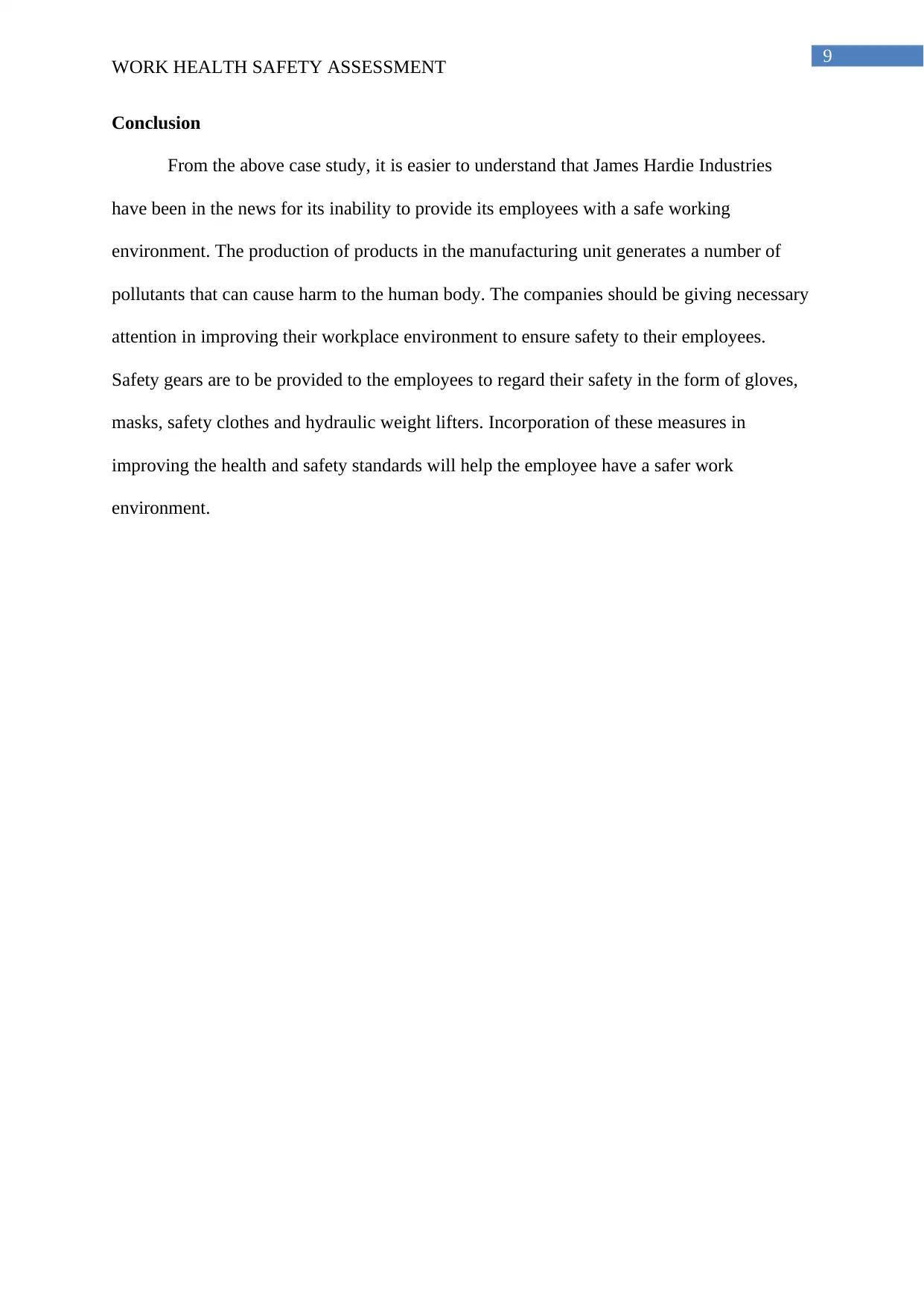
9
WORK HEALTH SAFETY ASSESSMENT
Conclusion
From the above case study, it is easier to understand that James Hardie Industries
have been in the news for its inability to provide its employees with a safe working
environment. The production of products in the manufacturing unit generates a number of
pollutants that can cause harm to the human body. The companies should be giving necessary
attention in improving their workplace environment to ensure safety to their employees.
Safety gears are to be provided to the employees to regard their safety in the form of gloves,
masks, safety clothes and hydraulic weight lifters. Incorporation of these measures in
improving the health and safety standards will help the employee have a safer work
environment.
WORK HEALTH SAFETY ASSESSMENT
Conclusion
From the above case study, it is easier to understand that James Hardie Industries
have been in the news for its inability to provide its employees with a safe working
environment. The production of products in the manufacturing unit generates a number of
pollutants that can cause harm to the human body. The companies should be giving necessary
attention in improving their workplace environment to ensure safety to their employees.
Safety gears are to be provided to the employees to regard their safety in the form of gloves,
masks, safety clothes and hydraulic weight lifters. Incorporation of these measures in
improving the health and safety standards will help the employee have a safer work
environment.
Paraphrase This Document
Need a fresh take? Get an instant paraphrase of this document with our AI Paraphraser
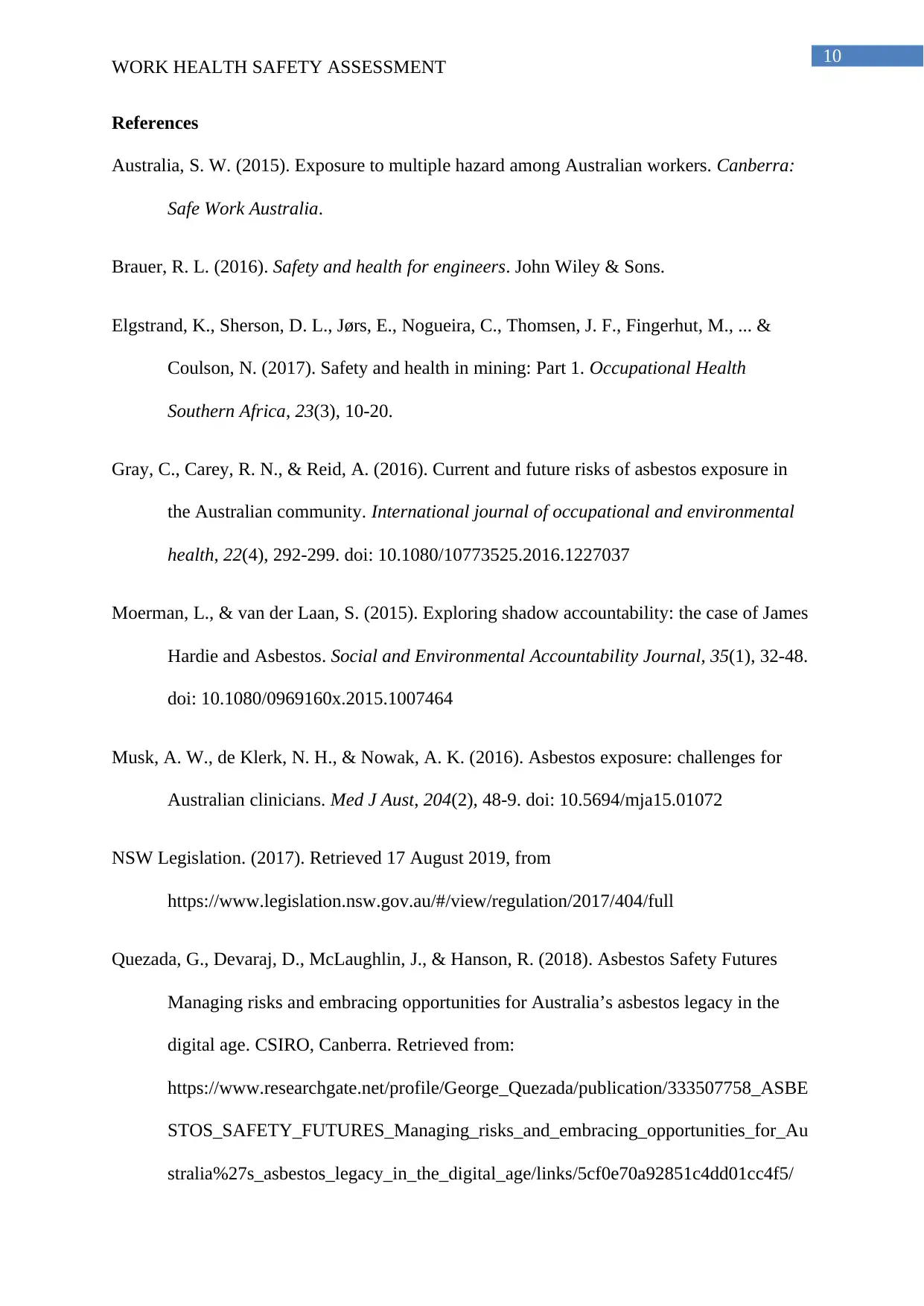
10
WORK HEALTH SAFETY ASSESSMENT
References
Australia, S. W. (2015). Exposure to multiple hazard among Australian workers. Canberra:
Safe Work Australia.
Brauer, R. L. (2016). Safety and health for engineers. John Wiley & Sons.
Elgstrand, K., Sherson, D. L., Jørs, E., Nogueira, C., Thomsen, J. F., Fingerhut, M., ... &
Coulson, N. (2017). Safety and health in mining: Part 1. Occupational Health
Southern Africa, 23(3), 10-20.
Gray, C., Carey, R. N., & Reid, A. (2016). Current and future risks of asbestos exposure in
the Australian community. International journal of occupational and environmental
health, 22(4), 292-299. doi: 10.1080/10773525.2016.1227037
Moerman, L., & van der Laan, S. (2015). Exploring shadow accountability: the case of James
Hardie and Asbestos. Social and Environmental Accountability Journal, 35(1), 32-48.
doi: 10.1080/0969160x.2015.1007464
Musk, A. W., de Klerk, N. H., & Nowak, A. K. (2016). Asbestos exposure: challenges for
Australian clinicians. Med J Aust, 204(2), 48-9. doi: 10.5694/mja15.01072
NSW Legislation. (2017). Retrieved 17 August 2019, from
https://www.legislation.nsw.gov.au/#/view/regulation/2017/404/full
Quezada, G., Devaraj, D., McLaughlin, J., & Hanson, R. (2018). Asbestos Safety Futures
Managing risks and embracing opportunities for Australia’s asbestos legacy in the
digital age. CSIRO, Canberra. Retrieved from:
https://www.researchgate.net/profile/George_Quezada/publication/333507758_ASBE
STOS_SAFETY_FUTURES_Managing_risks_and_embracing_opportunities_for_Au
stralia%27s_asbestos_legacy_in_the_digital_age/links/5cf0e70a92851c4dd01cc4f5/
WORK HEALTH SAFETY ASSESSMENT
References
Australia, S. W. (2015). Exposure to multiple hazard among Australian workers. Canberra:
Safe Work Australia.
Brauer, R. L. (2016). Safety and health for engineers. John Wiley & Sons.
Elgstrand, K., Sherson, D. L., Jørs, E., Nogueira, C., Thomsen, J. F., Fingerhut, M., ... &
Coulson, N. (2017). Safety and health in mining: Part 1. Occupational Health
Southern Africa, 23(3), 10-20.
Gray, C., Carey, R. N., & Reid, A. (2016). Current and future risks of asbestos exposure in
the Australian community. International journal of occupational and environmental
health, 22(4), 292-299. doi: 10.1080/10773525.2016.1227037
Moerman, L., & van der Laan, S. (2015). Exploring shadow accountability: the case of James
Hardie and Asbestos. Social and Environmental Accountability Journal, 35(1), 32-48.
doi: 10.1080/0969160x.2015.1007464
Musk, A. W., de Klerk, N. H., & Nowak, A. K. (2016). Asbestos exposure: challenges for
Australian clinicians. Med J Aust, 204(2), 48-9. doi: 10.5694/mja15.01072
NSW Legislation. (2017). Retrieved 17 August 2019, from
https://www.legislation.nsw.gov.au/#/view/regulation/2017/404/full
Quezada, G., Devaraj, D., McLaughlin, J., & Hanson, R. (2018). Asbestos Safety Futures
Managing risks and embracing opportunities for Australia’s asbestos legacy in the
digital age. CSIRO, Canberra. Retrieved from:
https://www.researchgate.net/profile/George_Quezada/publication/333507758_ASBE
STOS_SAFETY_FUTURES_Managing_risks_and_embracing_opportunities_for_Au
stralia%27s_asbestos_legacy_in_the_digital_age/links/5cf0e70a92851c4dd01cc4f5/
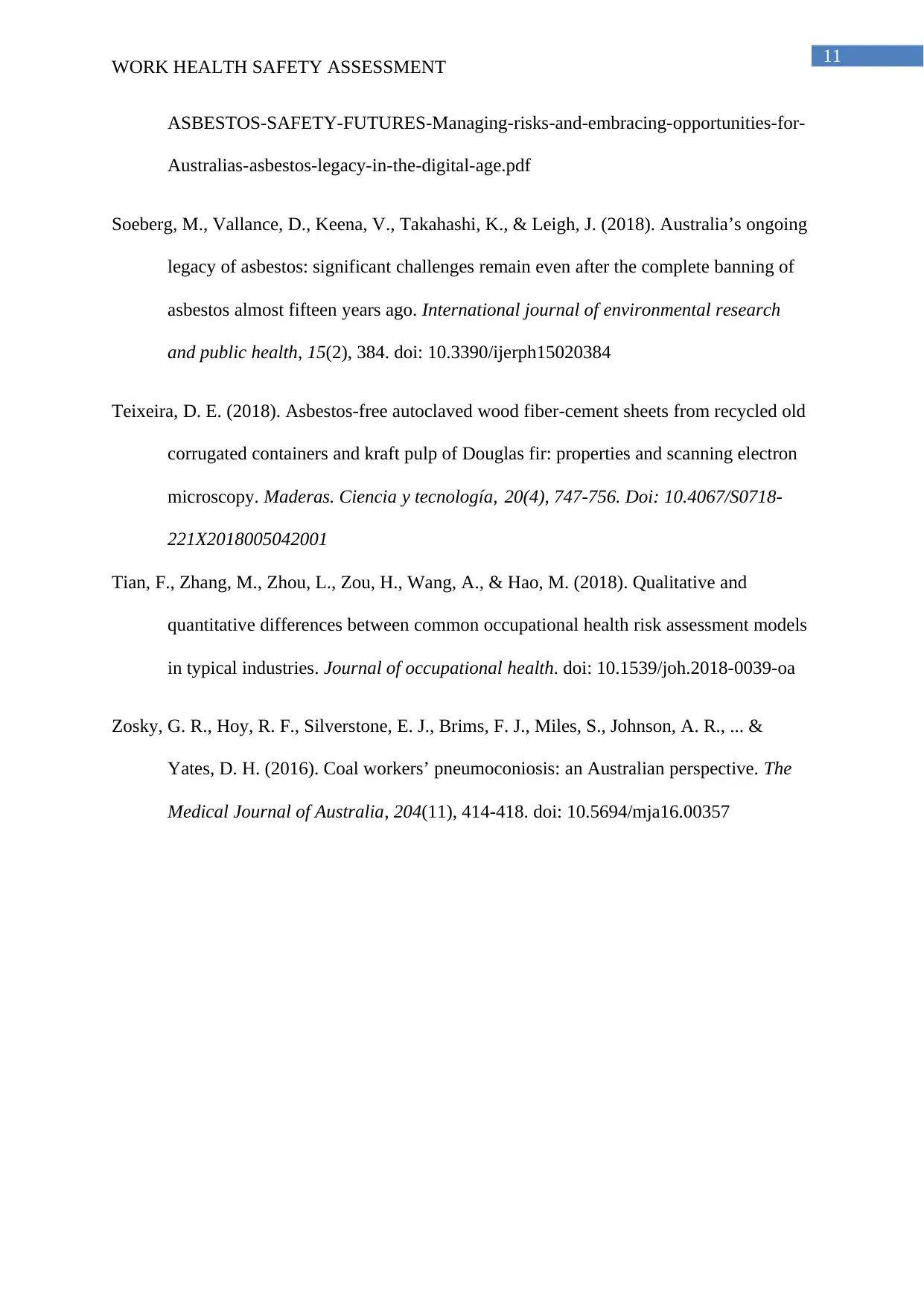
11
WORK HEALTH SAFETY ASSESSMENT
ASBESTOS-SAFETY-FUTURES-Managing-risks-and-embracing-opportunities-for-
Australias-asbestos-legacy-in-the-digital-age.pdf
Soeberg, M., Vallance, D., Keena, V., Takahashi, K., & Leigh, J. (2018). Australia’s ongoing
legacy of asbestos: significant challenges remain even after the complete banning of
asbestos almost fifteen years ago. International journal of environmental research
and public health, 15(2), 384. doi: 10.3390/ijerph15020384
Teixeira, D. E. (2018). Asbestos-free autoclaved wood fiber-cement sheets from recycled old
corrugated containers and kraft pulp of Douglas fir: properties and scanning electron
microscopy. Maderas. Ciencia y tecnología, 20(4), 747-756. Doi: 10.4067/S0718-
221X2018005042001
Tian, F., Zhang, M., Zhou, L., Zou, H., Wang, A., & Hao, M. (2018). Qualitative and
quantitative differences between common occupational health risk assessment models
in typical industries. Journal of occupational health. doi: 10.1539/joh.2018-0039-oa
Zosky, G. R., Hoy, R. F., Silverstone, E. J., Brims, F. J., Miles, S., Johnson, A. R., ... &
Yates, D. H. (2016). Coal workers’ pneumoconiosis: an Australian perspective. The
Medical Journal of Australia, 204(11), 414-418. doi: 10.5694/mja16.00357
WORK HEALTH SAFETY ASSESSMENT
ASBESTOS-SAFETY-FUTURES-Managing-risks-and-embracing-opportunities-for-
Australias-asbestos-legacy-in-the-digital-age.pdf
Soeberg, M., Vallance, D., Keena, V., Takahashi, K., & Leigh, J. (2018). Australia’s ongoing
legacy of asbestos: significant challenges remain even after the complete banning of
asbestos almost fifteen years ago. International journal of environmental research
and public health, 15(2), 384. doi: 10.3390/ijerph15020384
Teixeira, D. E. (2018). Asbestos-free autoclaved wood fiber-cement sheets from recycled old
corrugated containers and kraft pulp of Douglas fir: properties and scanning electron
microscopy. Maderas. Ciencia y tecnología, 20(4), 747-756. Doi: 10.4067/S0718-
221X2018005042001
Tian, F., Zhang, M., Zhou, L., Zou, H., Wang, A., & Hao, M. (2018). Qualitative and
quantitative differences between common occupational health risk assessment models
in typical industries. Journal of occupational health. doi: 10.1539/joh.2018-0039-oa
Zosky, G. R., Hoy, R. F., Silverstone, E. J., Brims, F. J., Miles, S., Johnson, A. R., ... &
Yates, D. H. (2016). Coal workers’ pneumoconiosis: an Australian perspective. The
Medical Journal of Australia, 204(11), 414-418. doi: 10.5694/mja16.00357
⊘ This is a preview!⊘
Do you want full access?
Subscribe today to unlock all pages.

Trusted by 1+ million students worldwide
1 out of 12
Related Documents
Your All-in-One AI-Powered Toolkit for Academic Success.
+13062052269
info@desklib.com
Available 24*7 on WhatsApp / Email
![[object Object]](/_next/static/media/star-bottom.7253800d.svg)
Unlock your academic potential
Copyright © 2020–2025 A2Z Services. All Rights Reserved. Developed and managed by ZUCOL.




